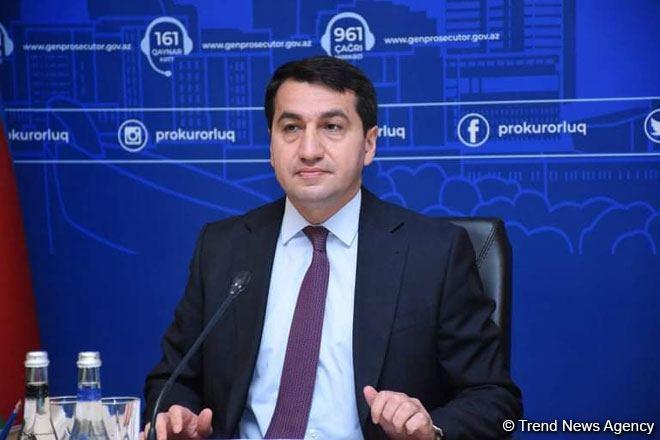Azerbaijan extends Armenians' withdrawal from Kalbajar until 25 November

By Vafa Ismayilova
Presidential aide Hikmat Hajiyev has said that Azerbaijan has extended the deadline for the Armenian troops' withdrawal from its Kalbajar region until 25 November.
Hajiyev made the remarks at a briefing in Baku on 15 November. The presidential aide added that Yerevan conveyed its relevant request to Baku through Moscow.
Hajiyev said that Azerbaijan agreed to give time to Armenia. Meanwhile, he stressed that the schedule for the withdrawal of Armenia’s troops from Lachin and Aghdam regions remains unchanged.
The presidential aide said that Azerbaijan is monitoring the process of withdrawal of the Armenian armed forces and civilians from the occupied territories by using technological capabilities.
On November 14, the Russian and Azerbaijani presidents discussed by phone practical aspects of implementation of the ceasefire deal. They hailed the fact that ceasefire is being observed and that the situation in the region is calm. They also discussed the protection of Christian shrines in the regions around Nagorno-Karabakh that Azerbaijan gets back under the trilateral peace deal.
Under the deal signed by Azerbaijani President Ilham Aliyev, Russian President Vladimir Putin and Armenian President Nikol Pashinyan on November 10, the Armenian armed forces were to completely withdraw from Kalbajar on November 15.
The declaration envisages the de-occupation of Azerbaijan’s Aghdam and Lachin regions by December 1 as well as the return of Azerbaijani IDPs to Azerbaijan’s Nagorno-Karabakh and seven adjacent regions under the control of the United Nations High Commissioner for Refugees.
Kalbajar was among seven Azerbaijani regions around Nagorno-Karabakh that got occupied by the Armenian armed forces.
The November peace agreement ended the 30-years-old conflict between Baku and Yerevan over Azerbaijan’s Nagorno-Karabakh region that along with the seven adjacent districts came under the occupation of Armenian armed forces in the war in the early 1990s. For nearly three decades, Armenia failed to implement the UN Security Council resolutions (822, 853, 874 and 884) demanding the withdrawal of its troops, which was the main obstacle to the resolution of the conflict. The OSCE Minsk Group co-chaired by the United States, Russia and France had been mediating the Armenian-Azerbaijani conflict since the signing of the volatile cease-fire agreement in 1994. The Minsk Group’s efforts resulted in no progress as Armenia refused to abide by the UN Security Council resolutions.
Under the deal, Russian peacekeepers are deployed in the region to patrol frontlines. Turkey also takes part in the peacekeeping process. Russia and Turkey signed a deal on creating a Russian-Turkish joint ceasefire monitoring centre.
The clashes between Armenia and Azerbaijan resumed after Armenia launched large-scale attacks on Azerbaijani forces and civilians on September 27. Five Azerbaijani civilians were killed on the first day of the Armenian attacks. Ninety-three Azerbaijani civilians were killed in Armenian's indiscriminate attacks on Azerbaijani civilians. Azerbaijan launched counter-offensive operations that ended in the liberation of over 300 settlements, villages. Azerbaijan also liberated five city centres and the historic Shusha city.
--
Follow us on Twitter @AzerNewsAz
Here we are to serve you with news right now. It does not cost much, but worth your attention.
Choose to support open, independent, quality journalism and subscribe on a monthly basis.
By subscribing to our online newspaper, you can have full digital access to all news, analysis, and much more.
You can also follow AzerNEWS on Twitter @AzerNewsAz or Facebook @AzerNewsNewspaper
Thank you!
